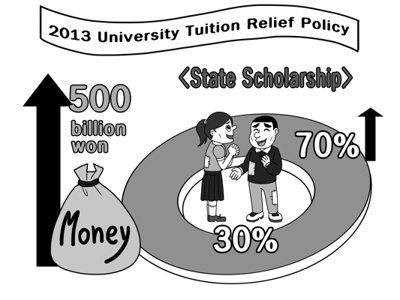2013 University Tuition Relief Policy to increase budget for scholarship

The Ministry of Education, Science and Technology (MEST) announced its 2013 University Tuition Relief Policy on Nov. 7. The policy with an increased budget allows more university students from low income households to be eligible for receiving a larger amount of state scholarships from the next year.
The total budget for state scholarship will be increased from 1.75 trillion won to 2.25 trillion won, which is up by 500 billion won. With an additional 600 billion to 700 billion funded by the universities, a sum of 2.85 trillion won is estimated to be used for tuition cuts.
“Korea’s university tuition is the second highest among OECD (Organization for Economic Cooperation and Development) members,” said Park Jae-sung, the Deputy Director of the Student Aid Department in the MEST. “Thus, we wanted to enhance the notion of such status and lessen the financial burden of both the students and parents by implementing this policy.”
The state scholarship system provided by the Korea Student Aid Foundation (KOSAF) is divided into two types: State Scholarship Type I and State Scholarship Type II.
Type I focuses on providing financial aid to university students who come from families in the bottom 30 percent of the income bracket level.
This level is divided into 10 parts depending on the amount of income in a household and such standard is determined by the Ministry of Health & Welfare.
On the other hand, Type II allows university students from households in the bottom 70 percent of the income bracket level to receive scholarships according to the degree of their parents’ income.
Furthermore, it is closely related to universities’ efforts in lowering tuition fees or enlarging their scholarship amount. The more such efforts are exerted, the larger the amount of funds the KOSAF subsidizes.
The 2013 University Tuition Relief Policy, therefore, has modified some regulations on the state scholarship to further alleviate the students’ financial burden for tuition.
With the implementation of the relief policy, students from households in the bottom 70 percent income bracket will also be eligible to receive State Scholarship Type I, which was only given to those in the bottom 30 percent in 2012.
Moreover, the original amount of state funds provided to the bottom 30 percent will also be increased by 450,000 won to 900,000 won.
The former requisites, to meet the minimum grade point average of 3.3 out of 4.3 and to have taken at least 12 credits in the previous semester to be granted state scholarship, are still applied to the currently enrolled students.
However, starting next year, freshmen will not be subjected to such degrees in their first semester. Moreover, they will not be required to submit their grades of the College Scholastic Aptitude Test in order to be eligible for the state scholarship.
Thus, the newly accepted university students of 2013 from households in the bottom 70 percent will all be funded with State Scholarship Type I.
In addition to the modifications, the MEST further plans to benefit those who do not meet the qualifications under specific circumstances such as a sudden change in financial situations of a household.
The MEST has made improvements in the flexibility of the conditions for students in need of State Scholarship Type II by relieving some terms on grades, the number of credits, and the income bracket.
There are some controversies regarding the imminent application of the policy in that it does not tackle the prime problem of high tuition. On such matter, as the MEST has its policies focused on the income bracket level, it hopes to relieve the financial burden of those especially in need.
“The MEST will try its best to alleviate the tuition burden of students from low income families and increase the development of scholarship policies on a ‘need-base’ system,” Park said.

